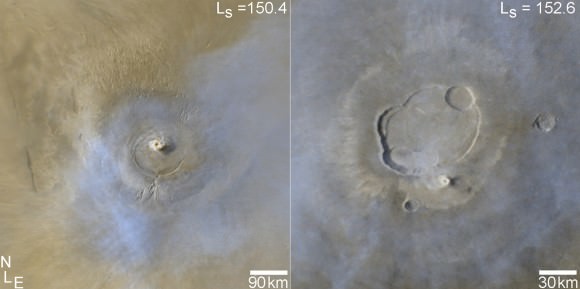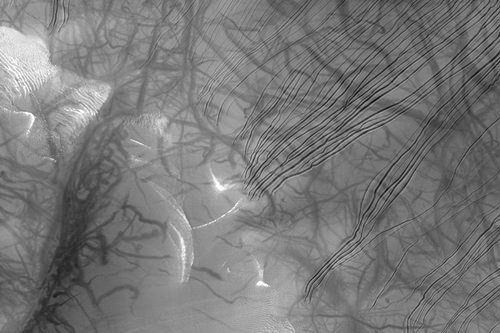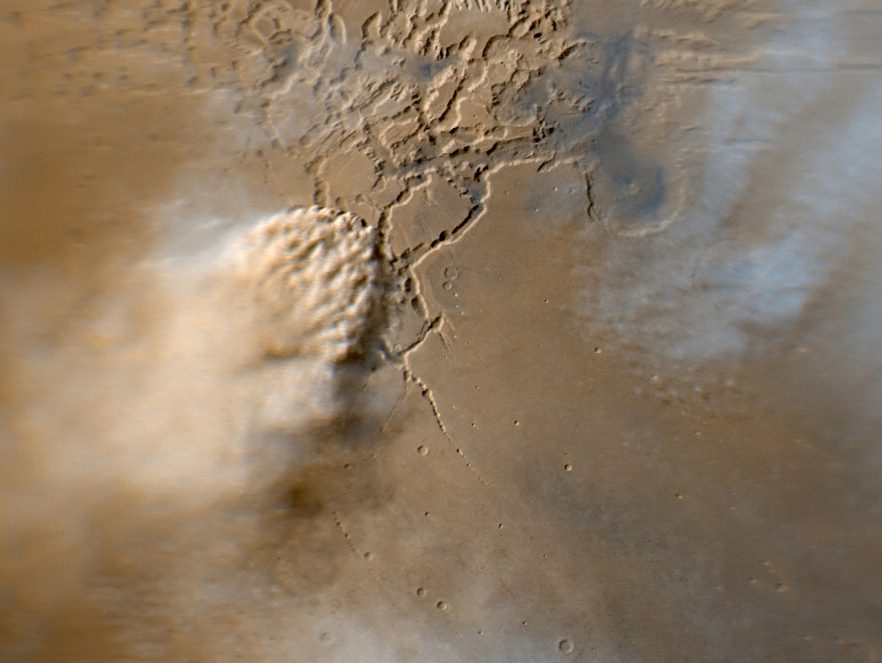[/caption]
What an incredible image of a storm on Mars! The Mars Reconnaissance Orbiter’s main assignment is to study the surface of the Red Planet, looking for clues about the history of water on Mars. But while photographing, analyzing and mapping, it also spends time each day pursuing intense weather on Mars. Sometimes, MRO is able to capture a storm in action, as in the above image of a dust front rising from a network of canyons. Often, the storms are spirals like giant tornadoes on Earth, sometimes forming huge fronts of churning dust like the “dust bowl” of the 1930s in the US. While we sometimes think of Mars as an almost “dead” world, there’s a lot of action going on in the atmosphere, and MRO is always searching for the Perfect Storm!
Dust storms on Mars are catalysts for cloud formation. The storms lift dust particles high into the atmosphere, and the particles serve as seeds for water-ice cloud formation. Water ice condenses onto the dust particles to form wispy, white clouds. Daily variations in Mars’ atmosphere are quite large, in part because there is no ocean, which serves as large heat storage capacity on the surface. The ground warms up quickly during the day and cools off equally as quick at night. Daily temperature variations of 100 C (180 F) are common, and that cycle of heating and cooling is reflected in atmospheric variations. “That energy propagates up, and when integrated to the high altitudes, it can make a big difference from day to night in the densities that we saw at a given altitude,” said MRO Project Scientist Richard Zurek.

These images show whirlwinds on top of volcanoes. Thin veils of icy clouds dissipate into the atmosphere above the dust plumes. The orbiter has discovered that smaller storms on Mars can feed into larger storms.

And of course, dust devils on Mars are a common occurrence in several areas, as they have been photographed by both the Mars Exploration Rovers, as well as Phoenix.
Sources: MRO website, HiRISE site


What are the image numbers for these shots ? Especially the first one. It reminds me of the image of the land slip
Where can I find above images in higher resolution?
Spectacular!
When where these photo taken? Is there any detail on them? I don’t see them on the HiRise or MARI sites.
Check the sources links to find more info on the images.
Nancy
The first one in particular is a stunner. Reminds me of an aerial shot of a bushfire or something.
Unless I’m much mistaken (and without following the links, which is not a smart thing to do… but I have an aliby: I’m sleepy) the first one shows the fractured terrain that separates the Tharsis plateau from Vallis Marineris. If so, the sandstorm is pretty large, maybe between 100-200 km across.
Not quite a landslip.
Hm… now I’m getting too curious to go away without checking the sources. Sigh… OK, here I go.
Back… got the size right, and they don’t say where it is, so I’m sticking with what’s written above.
Your location spotting is correct ! It’s near Noctis Labyrinthus. No, it’s not the right size for a land slip, I was just saying that it reminded me of that image for eye popping value.
Consider the low mass of the martian atmosphere and statements by some of the JPL scientists that erosion and deposition are at extremely low rates because the wind has barely enough energy to lift the dust grains. Then consider the energetic looking storm that appears to be emanating or eating away an a canyon in Noctis. Also the recent discovery of, as the scientists amusingly put it, “magnetic chunks of atmosphere getting ripped away from Mars” . Conclusion – This is likely an electrically powered storm as are the individual vortices of the dust devils, with the characteristic spiral of a birkeland (field-aligned current). Note the picture with the dust devil tracks among the long thin “gullies”. Again, two aspect of the same phenomenon. A more powerful dust devil – a dusty discharging plasma current – gouged the surface to make the gullies. Similar phenomenon for slope streaks with the color change coming from an electrochemical reaction.
Some details about “dust devils”: the first is caught in the crater of Arsia Mons, the second – undoubtly near the famous Olympus caldera.